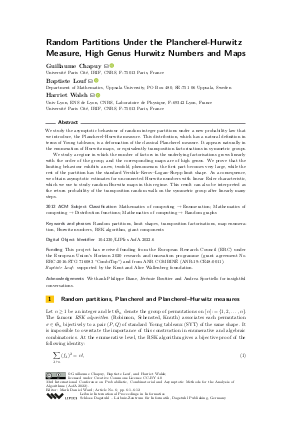Random Partitions Under the Plancherel-Hurwitz Measure, High Genus Hurwitz Numbers and Maps
Authors
Guillaume Chapuy  ,
Baptiste Louf
,
Baptiste Louf  ,
Harriet Walsh
,
Harriet Walsh 
-
Part of:
Volume:
33rd International Conference on Probabilistic, Combinatorial and Asymptotic Methods for the Analysis of Algorithms (AofA 2022)
Part of: Series: Leibniz International Proceedings in Informatics (LIPIcs)
Part of: Conference: International Conference on Probabilistic, Combinatorial and Asymptotic Methods for the Analysis of Algorithms (AofA) - License:
 Creative Commons Attribution 4.0 International license
Creative Commons Attribution 4.0 International license
- Publication Date: 2022-06-08
File

PDF
LIPIcs.AofA.2022.6.pdf
- Filesize: 0.98 MB
- 12 pages
Document Identifiers
Subject Classification
ACM Subject Classification
- Mathematics of computing → Enumeration
- Mathematics of computing → Distribution functions
- Mathematics of computing → Random graphs
Keywords
- Random partitions
- limit shapes
- transposition factorisations
- map enumeration
- Hurwitz numbers
- RSK algorithm
- giant components
Metrics
- Access Statistics
-
Total Accesses (updated on a weekly basis)
0PDF Downloads0Metadata Views
Abstract
We study the asymptotic behaviour of random integer partitions under a new probability law that we introduce, the Plancherel-Hurwitz measure. This distribution, which has a natural definition in terms of Young tableaux, is a deformation of the classical Plancherel measure. It appears naturally in the enumeration of Hurwitz maps, or equivalently transposition factorisations in symmetric groups. We study a regime in which the number of factors in the underlying factorisations grows linearly with the order of the group, and the corresponding maps are of high genus. We prove that the limiting behaviour exhibits a new, twofold, phenomenon: the first part becomes very large, while the rest of the partition has the standard Vershik-Kerov-Logan-Shepp limit shape. As a consequence, we obtain asymptotic estimates for unconnected Hurwitz numbers with linear Euler characteristic, which we use to study random Hurwitz maps in this regime. This result can also be interpreted as the return probability of the transposition random walk on the symmetric group after linearly many steps.
Cite As Get BibTex
Guillaume Chapuy, Baptiste Louf, and Harriet Walsh. Random Partitions Under the Plancherel-Hurwitz Measure, High Genus Hurwitz Numbers and Maps. In 33rd International Conference on Probabilistic, Combinatorial and Asymptotic Methods for the Analysis of Algorithms (AofA 2022). Leibniz International Proceedings in Informatics (LIPIcs), Volume 225, pp. 6:1-6:12, Schloss Dagstuhl – Leibniz-Zentrum für Informatik (2022)
https://doi.org/10.4230/LIPIcs.AofA.2022.6
BibTex
@InProceedings{chapuy_et_al:LIPIcs.AofA.2022.6,
author = {Chapuy, Guillaume and Louf, Baptiste and Walsh, Harriet},
title = {{Random Partitions Under the Plancherel-Hurwitz Measure, High Genus Hurwitz Numbers and Maps}},
booktitle = {33rd International Conference on Probabilistic, Combinatorial and Asymptotic Methods for the Analysis of Algorithms (AofA 2022)},
pages = {6:1--6:12},
series = {Leibniz International Proceedings in Informatics (LIPIcs)},
ISBN = {978-3-95977-230-3},
ISSN = {1868-8969},
year = {2022},
volume = {225},
editor = {Ward, Mark Daniel},
publisher = {Schloss Dagstuhl -- Leibniz-Zentrum f{\"u}r Informatik},
address = {Dagstuhl, Germany},
URL = {https://drops.dagstuhl.de/entities/document/10.4230/LIPIcs.AofA.2022.6},
URN = {urn:nbn:de:0030-drops-160921},
doi = {10.4230/LIPIcs.AofA.2022.6},
annote = {Keywords: Random partitions, limit shapes, transposition factorisations, map enumeration, Hurwitz numbers, RSK algorithm, giant components}
}
Author Details
Funding
This project has received funding from the European Research Council (ERC) under the European Union’s Horizon 2020 research and innovation programme (grant agreement No. ERC-2016-STG 716083 "CombiTop") and from ANR COMBINÉ (ANR-19-CE48-0011).
- Louf, Baptiste: supported by the Knut and Alice Wallenberg foundation.
Acknowledgements
We thank Philippe Biane, Jérémie Bouttier and Andrea Sportiello for insightful conversations.
References
-
P. Biane. Approximate factorization and concentration for characters of symmetric groups. International Mathematics Research Notices, 2001(4):179-192, January 2001.

- A. Borodin and V. Gorin. Lectures on integrable probability. In Probability and Statistical Physics in St. Petersburg, volume 91 of Proceedings of Symposia in Pure Mathematics, pages 155-214. AMS, 2016. URL: http://arxiv.org/abs/1212.3351.
-
A. Borodin, A. Okounkov, and G. Olshanski. Asymptotics of Plancherel measures for symmetric groups. J. Amer. Math. Soc., 13(3):481-515, July 2000.

-
M. Bousquet-Mélou and G. Schaeffer. Enumeration of planar constellations. Advances in Applied Mathematics, 24(4):337-368, 2000.

-
E. Brézin, C. Itzykson, G. Parisi, and J. B. Zuber. Planar diagrams. Communications in Mathematical Physics, 59(1):35-51, 1978.

-
T. Budzinski and B. Louf. Local limits of uniform triangulations in high genus. Inventiones mathematicae, 223, January 2021.

-
G. Chapuy, M. Marcus, and G. Schaeffer. A bijection for rooted maps on orientable surfaces. SIAM J. Discrete Math., 23(3):1587-1611, 2009.

-
P. Diaconis and M. Shahshahani. Generating a random permutation with random transpositions. Zeitschrift für Wahrscheinlichkeitstheorie und Verwandte Gebiete, 57:159-179, 1981.

-
B. Dubrovin, D. Yang, and D. Zagier. Classical hurwitz numbers and related combinatorics. Moscow Mathematical Journal, 17:601-633, October 2017.

- E. Duchi, D. Poulalhon, and G. Schaeffer. Bijections for simple and double Hurwitz numbers, 2014. URL: http://arxiv.org/abs/1410.6521.
-
B. Eynard and N. Orantin. Invariants of algebraic curves and topological expansion. Communications in Number Theory and Physics, 1, March 2007.

-
W. Fulton. Young Tableaux: With Applications to Representation Theory and Geometry. London Mathematical Society Student Texts. Cambridge University Press, 1996.

-
I.P. Goulden and D.M. Jackson. The KP hierarchy, branched covers, and triangulations. Advances in Mathematics, 219(3):932-951, 2008.

-
K. Johansson. The longest increasing subsequence in a random permutation and a unitary random matrix model. Mathematical Research Letters, 5:63-82, January 1998.

-
B.F. Logan and L.A. Shepp. A variational problem for random Young tableaux. Advances in Mathematics, 26(2):206-222, 1977.

-
A. Okounkov. Toda equations for Hurwitz numbers. Math. Res. Lett., 7(4):447-453, 2000.

-
D. Romik. The Surprising Mathematics of Longest Increasing Subsequences. Institute of Mathematical Statistics Textbooks. Cambridge University Press, 2015.

-
W. T. Tutte. A census of planar maps. Canadian Journal of Mathematics, 15:249-271, 1963.

-
A.M. Vershik and S.V. Kerov. Asymptotics of the Plancherel measure of the symmetric group and the limiting form of Young tableaux. Doklady Akademii Nauk, 233(6):1024-1027, 1977.

